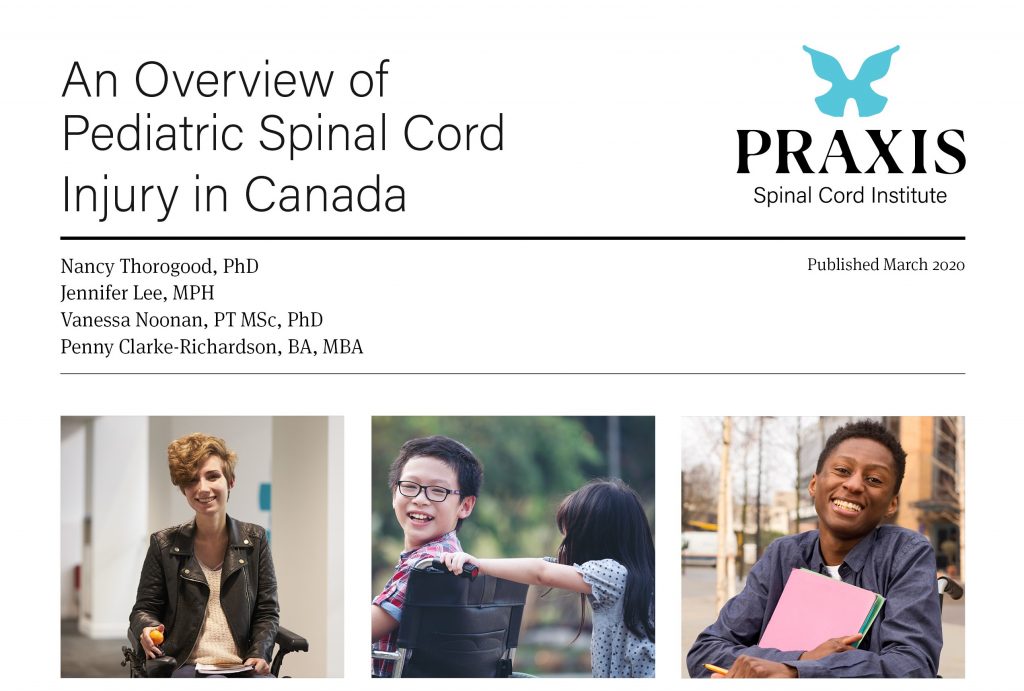Publications
Praxis is strongly committed to sharing details of the great work that is taking place throughout the SCI field. Explore SCI-related scientific papers, reports and more.

This is the breadcrumbs block. Breadcrumb will populate on actual page.
James A.G. Crispo, MSc, PhD; Lisa J.W. Liu, MPH; Vanessa K. Noonan, PhD, PT; Nancy P. Thorogood, PhD; Brian K. Kwon, MD, PhD; Marcel F. Dvorak, MD, MBA; Dylan Thibault, MSc; Allison Willis, MSc, MD; Jacquelyn J. Cragg, MPH, PhD
Top Spinal Cord Inj Rehabil vol. 28 (1), pp. 1–12. (2022). https://doi.org/10.46292/sci21-00047
Traumatic spinal cord injury (tSCI) is a debilitating neurological condition often associated with lifelong disability. Despite this, there are limited data on pediatric tSCI epidemiology in the United States.
Our primary objective was to estimate tSCI hospitalization rates among children, including by age, sex, and race. Secondary objectives were to characterize tSCI hospitalizations and examine associations between sociodemographic characteristics and tSCI etiology.
We used the 2016 Kids’ Inpatient Database to examine tSCI hospitalizations among children (<21 years). Descriptive statistics were used to report individual and care setting characteristics for initial tSCI hospitalizations. We used Census Bureau data to estimate tSCI hospitalization rates (number of pediatric tSCI hospitalizations / number of US children) and logistic regression modeling to assess associations between documented sociodemographic characteristics and injury etiology.
There were 1.48 tSCI admissions per 100,000 children; highest rates of hospitalization involved older (15–20 years), male, and Black children. Hospitalization involving male (adjusted odds ratio [AOR] 0.43; 95% CI, 0.33–0.58) or Black (AOR 0.37; 95% CI, 0.25–0.55) children were less likely to involve a motor traffic accident. Hospitalizations of Black children were significantly more likely to have a diagnosis of tSCI resulting from a firearm incident (AOR 18.97; 95% CI, 11.50–31.28) or assault (AOR 11.76; 95% CI, 6.75–20.50) compared with hospitalizations of White children.
Older, male, and Black children are disproportionately burdened by tSCI. Implementation of broad health policies over time may be most effective in reducing pediatric tSCI hospitalizations and preventable injuries.
Continue to the article.
There is limited knowledge on the demographics traumatic spinal cord injuries (SCI) in American children.
We used an existing hospital database from 2016 gathered from across the United States to explore differences in age, sex, and race and to see if they played a role in how an injury happened. Nearly half of all hospitalizations were for cervical spinal cord injuries.
We also saw that traumatic SCI, while rare, happened more frequently to older (15-20 years old), male, and black children compared to other demographics. They were also much more likely to acquire an SCI through more preventable causes such as through a firearm or assault incident.
This study highlights the imbalance between different groups and how new policies need change in order to decrease this gap.
Praxis is strongly committed to sharing details of the great work that is taking place throughout the SCI field. Explore SCI-related scientific papers, reports and more.
